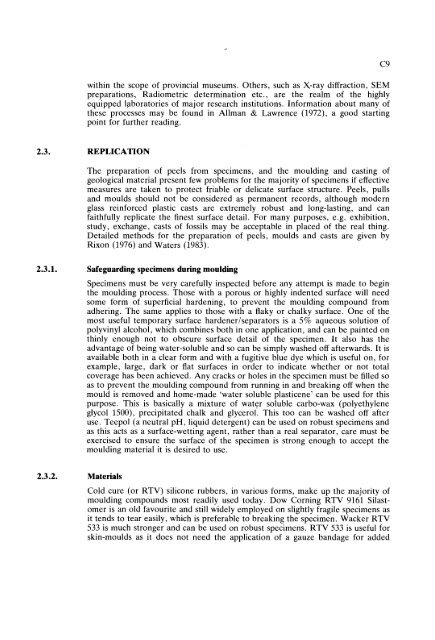GUIDELINES FOR THE CURATION OF GEOLOGICAL MATERIALS
GUIDELINES FOR THE CURATION OF GEOLOGICAL MATERIALS
GUIDELINES FOR THE CURATION OF GEOLOGICAL MATERIALS
Create successful ePaper yourself
Turn your PDF publications into a flip-book with our unique Google optimized e-Paper software.
within the scope of provincial museums. Others, such as X-ray diffraction, SEM<br />
preparations, Radiometric determination etc., are the realm of the highly<br />
equipped laboratories of major research institutions. Information about many of<br />
these processes may be found in Allman & Lawrence (1972), a good starting<br />
point for further reading.<br />
REPLICATION<br />
The preparation of peels from specimens, and the moulding and casting of<br />
geological material present few problems for the majority of specimens if effective<br />
measures are taken to protect friable or delicate surface structure. Peels, pulls<br />
and moulds should not be considered as permanent records, although modern<br />
glass reinforced plastic casts are extremely robust and long-lasting, and can<br />
faithfully replicate the finest surface detail. For many purposes, e.g. exhibition,<br />
study, exchange, casts of fossils may be acceptable in placed of the real thing.<br />
Detailed methods for the preparation of peels, moulds and casts are given by<br />
Rixon (1976) and Waters (1983).<br />
Safeguarding specimens during moulding<br />
Specimens must be very carefully inspected before any attempi is made to begin<br />
the moulding process. Those with a porous or highly indented surface will need<br />
some form of superficial hardening, to prevent the moulding compound from<br />
adhering. The same applies to those with a flaky or chalky surface. One of the<br />
most useful temporary surface hardenerlseparators is a 5% aqueous solutiofi of<br />
polyvinyl alcohol, which combines both in one application, and can be painted on<br />
thinly enough not to obscure surface detail of the specimen. It also has the<br />
advantage of being water-soluble and so can be simply washed off afterwards. It is<br />
available both in a clear form and with a fugitive blue dye which is useful on, for<br />
example, large, dark or flat surfaces in order to indicate whether or not total<br />
coverage has been achieved. Any cracks or holes in the specimen must be filled so<br />
as to prevent the moulding compound from running in and breaking off when the<br />
mould is removed and home-made 'water soluble plasticene' can be used for this<br />
purpose. This is basically a mixture of water soluble carbo-wax (polyethylene<br />
glycol 1500), precipitated chalk and glycerol. This too can be washed off after<br />
use. Teepol (a neutral pH, liquid detergent) can be used on robust specimens and<br />
as this acts as a surface-wetting agent, rather than a real separator, care must be<br />
exercised to ensure the surface of the specimen is strong enough to accept the<br />
moulding material it is desired to use.<br />
Materials<br />
Cold cure (or RTV) silicone rubbers, in various forms, make up the majority of<br />
moulding compounds most readily used today. Dow Corning RTV 9161 Silastomer<br />
is an old favourite and still widely employed on slightly fragile specimens as<br />
it tends to tear easily, which is preferable to breaking the specimen. Wacker RTV<br />
533 is much stronger and can be used on robust specimens. RTV 533 is useful for<br />
skin-moulds as it does not need the application of a gauze bandage for added

















